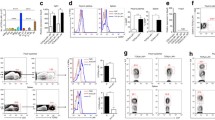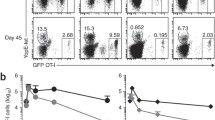Summary and Conclusions
Lamina propria T cells have a low expression of the CD45RA antigen and a high expression of the CD45RO antigen. This phenotype is characteristic for memory T cells (table 2). In addition, T cells in the effector compartment of the mucosa bear surface antigens which are very rarely found in other sites of the immune system. Intestinal T cells also express functional IL-2 receptors and IL-2 receptor α chain mRNA, and are able to synthesize high amounts of IL-2. However, another marker of memory T cells, CD29, is not expressed in high density in the lamina propria indicating that lamina propria T cells differ from ‘classical’ memory T cells. This is supported by functional studies in nonhuman primates infected rectally withC. trachomatis which show that lamina propria T cells do not proliferate after stimulation with antigen but rather provide helper function for immunoglobulin synthesis (table 2).
The intestinal lamina propria therefore contains highly specialized T cells which have a distinctive phenotype and are activated. Functionally these T cells can be characterized as differentiated effector lymphocytes which respond to triggering the antigen-specific T cell receptor by secreting helper factors for B cells. This concept is supported by recent studies showing that the pattern of lymphokines produced by lamina propria T cells and the responsiveness to certain lymphokines differ from those of other lymphocyte populations [25]. Lamina propria T cells thus represent a subset of memory T cells with a unique maturational state.
Similar content being viewed by others
References
Strober W, Jacobs D: Cellular differentiation, migration, and function in the mucosal immune system, in Gallin JI, Fauci AS (eds): Advances in Host Defense Mechanisms. New York, Raven Press, 1985, vol 4, pp 1–30.
James SP, Zeitz M, Kanof ME, Kwan WC: Intestinal lymphocyte populations and mechanisms of cell-mediated immunity; in: Kagnoff MF (ed): Immunology and Allergy Clinics of North America, vol 8, No 3: Gut and Intestinal Immunology. Philadelphia, Saunders, 1988, pp. 369–391.
Zeitz M, Schieferdecker HL, James SP, Riecken EO: Special functional features of T-lymphocyte subpopulations in the effector compartment of the intestinal mucosa and their relation to mucosal transformation. Digestion 1990;46(suppl 2):280–289.
Akbar AN, Terr L, Timms A, Beverley PCL, Janossy G: Loss of CD45R and gain of UCHL1 reactivity is a feature of primed T cells. J Immunol 1988;140:2171–2178.
Clement LT, Yamashita N, Martin AM: The functionally distinct subpopulations of human CD4+ helper/inducer T lymphocytes defined by anti-CD45R antibodies derive sequentially from a differentiation pathway that is regulated by activation—dependent post-thymic differentiation. J Immunol 1988;141:1464–1470.
Sanders ME, Malegapuru W, Makgoba MW, Shaw S: Human naive and memory T cells: Reinterpretation of helper-inducer and suppressor-inducer subsets. Immunol Today 1988;9:195–199.
Streuli M, Hall LR, Saga Y, Schlossman SF, Saito H: Differential usage of three exons generate at least five different mRNAs encoding human leucoyte common antigens. J Exp Med 1987;166:1548–1566.
Sanders ME, Makgoba MW, Sharrow SO, Stephany D, Springer TA: Human memory T lymphocytes express increased levels of three cell adhesion molecules (LFA-3, CD2, and LFA-1) and three other molecules (UCHL-1, CDw29, and Pgp-1) and have enhanced IFN-γ production. J Immunol 1988;140:1401–1407.
Ullrich R, Schieferdecker HI, Ziegler K, Riecken EO, Zeitz M: γδ T cells in the human intestine express surface markers of activation and are preferentially located in the epithelium. Cell Immunol 1990;128:619–627.
Selby WS, Janossy G, Bofill M, Jewell DP: Lymphocyte subpopulations in the human small intestine. The findings in normal mucosa and in the mucosa of patients with adult coeliac disease. Clin Exp Immunol 1983;52:219–228.
Schieferdecker HL, Ullrich R, Weiss-Breckwoldt AN, Schwarting R, Stein H, Riecken EO, Zeitz M: The HML-1 antigen of intestinal lymphocytes is an activation antigen. J Immunol 1990;144:2541–2549.
James SP, Fiocchi C, Graeff AS, Strober W: Phenotypic analysis of lamina propria lymphocytes. Predominance of helper-inducer and cytolytic T-cell phenotypes in Crohn's disease and control patients. Gastroenterology 1986;91:1483–1489.
James SP, Graeff AS, Zeitz M: Predominance of helper-inducer T cells in mesenteric lymph nodes and intestinal lamina propria of normal nonhuman primates. Cell Immunol 1987;107:372–383.
Camerini D, James SP, Stamenkovic I, Seed B: Leu-8/TQ1 is the human equivalent of the Mel-14 lymph node homing receptor. Nature 1989;342:78–82.
Cerf-Bensussan N, Guy-Grand D, Lisowska-Grospierre B, Griscelli C, Bhan AK: A monoconal antibody specific for rat intestinal lymphocytes. J Immunol 1986;136:76–82.
Cerf-Bensussan N, Jarry A, Brousse N, Lisowska-Grospierre B, Guy-Grand D, Griscelli C: A monoclonal antibody (HML-1) defining a novel membrane molecule present on human intestinal lymphocytes. Eur J Immunol 1987;17:1279–1285.
Kruschwitz MG, Fritzsche G, Schwarting R, Micklem K, Mason DY, Falini B, Stein H: Ber ACT8: A new monoclonal antibody defining a trimeric antigen associated with activated CD8 T cells, gut mucosa T cells, and hair leukemia cells. Submitted for publication.
Picker LJ, Terstappen LWMM, Rott LS, Streeter PR, Stein H, Butcher EC: Differential expression of homing-associated adhesion molecules by T cells subsets in man. J Immunol 1990;145:3247–3255.
Greene WC, Leonard WJ, Depper JM: Growth of human T lymphocytes: An analysis of interleukin 2 and its cellular receptor. Prog Hematol 1986;14:283–301.
Zeitz M, Greene WC, Pfeffer NJ, James SP: Lymphocytes isolated from the intestinal lamina propria of normal nonhuman primates have increased expression of genes associated with T-cell activation. Gastroenterology 1988;94:647–655.
Peters M, Secrist H, Anders KR, Nash GS, Schloemann S, MacDermott RP: Increased expression of cell surface activation markers by intestinal mononuclear cells. Clin Res 1986;35:462.
Ullrich R, Zeitz M, Heise W, L'Age M, Ziegler K, Bergs C, Riecken EO: Mucosal atrophy is associated with loss of activated T cells in the duodenal mucosa of human immunodeficiency virus (HIV)-infected patients. Digestion 1990;46(suppl 2): 302–307.
Zeitz M, Quinn TC, Graeff AS, James SP: Mucosal T cells provide helper function but do not proliferate when stimulated by specific antigen in lymphogranuloma venerum proctitis in nonhuman primates. Gastroenterology 1988;94:353–366.
Pirzer UC, Schürmann G, Post S, Betzler M, Meuer SC: Differential responsiveness to CD3-Ti vs. CD2-dependent activation of human intestinal T lymphocytes. Eur J Immunol 1990;20:2339–2342.
James SP, Kwan WC, Sneller MC: T cells in inductive and effector compartments of the intestinal immune system of nonhuman primates differ in lymphokine mRNA expression, lymphokine utilization, and regulatory function. J Immunol 1990;144:1251–1256.
Author information
Authors and Affiliations
Additional information
Dedicated to professor Dr. Wolfgang Gerok, Freiburg, FRG, on the occasion of his 65th birthday.
Supported by a grant from the ‘Deutsche Forschungsgemeinschaft’ (Ze 188/4-2).
Rights and permissions
About this article
Cite this article
Zeitz, M., Schieferdecker, H.L., Ullrich, R. et al. Phenotype and function of lamina propria T lymphocytes. Immunol Res 10, 199–206 (1991). https://doi.org/10.1007/BF02919693
Issue Date:
DOI: https://doi.org/10.1007/BF02919693




